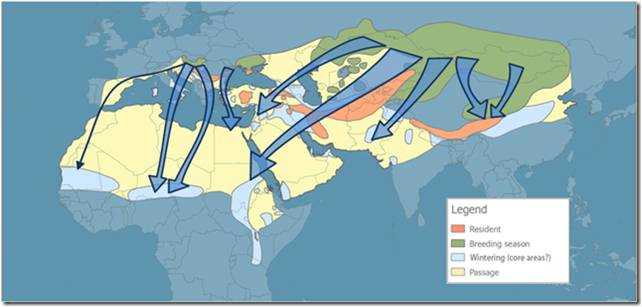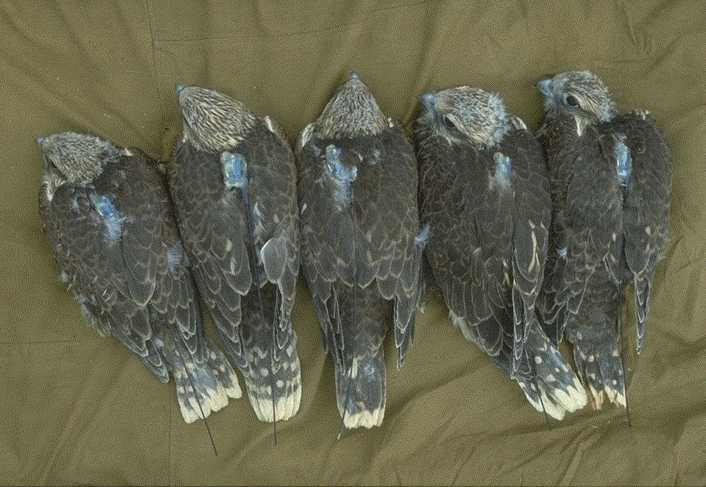The steppes of central Asia are a cradle of humanity, from which waves of people spread in huge, prolonged movements to west and east. We do not know what changes in climate drove these movements. However, the changes between summer and winter are enough to cause migration of the Saker falcons, which have been familiar for millennia to people of the steppes.
Sakers in Summer and Winter

Where Sakers live year-round (red), or migrate from breeding areas (green) to wintering areas (blue)
Sakers that breed in the most northern parts of Asia cannot stay there in the snow of winter, as their prey are hibernating or have flown south. The Sakers therefore fly south too, in the most extreme cases from the northern steppes of Central Asian to the grasslands of East Africa. Other Sakers make shorter movements, remaining within Asia or travelling from Europe to West and Central Africa. Sakers from the cliff-nesting areas to the south of the steppes face less snow in winter and may merely move short distances. Thirty years ago they frequently hunted pigeons in towns in winter, but few are seen there now.
The migratory Sakers are those of great traditional importance for the falconers of southwest Asia and Africa. These falcons were used for hunting the Houbara that also bred in the steppes and migrated south, or were resident year-round in areas where Sakers came for winter. Much has changed now, and we no longer understand what routes the falcons follow, or what new threats to their numbers may develop as they travel or seek to feed in winter. Expansion of farming, excessive grazing and changing climate are threats in many areas.
Marking with Rings and Radios

A brood of 5 Sakers in an area from which they migrate to Africa, all marked with rings, microchips and short-range radios. In future, more powerful radio tags are needed. Can you Donate to help?
In order to help the Sakers in their breeding areas, we need to encourage local communities to value them as breeders and to assist in marking schemes. Marking with leg-rings and microchips is very important for discovering how many Sakers are bred, harvested, and survive to breed. Those who trap Sakers can be very important for study of such birds, by reporting those they trap. Falconers too can help this work, by getting their birds checked for microchips at falcon hospitals. It is always wise to check the health of newly acquired wild falcons.
For learning about their travels before migrating, young Sakers were first marked with short-range radios that lasted two years and could tell when they returned to breeding areas. However, it is now most important to discover their migration routes and where they go in winter. Then the local people can be encouraged to keep those areas suitable for Sakers, for instance by making power-lines safe. To discover where they travel in winter, new radio transmitters are now available, which record GPS locations and send them either to satellites or to mobile phone stations when these are within range.
Where do our Sakers go?
If would like to help record where Sakers migrate, you can contribute to the cost of equipping a Saker and paying its phone bill. We can then show on this page where the bird is moving. Please use the Donate button to make contact with us for details.
We also need help to do more work on DNA and other biological markers, to see whether a small feather from trapped Sakers can reveal where in the north they came from. Will trappers be interested enough to provide a small feather from their precious capture?